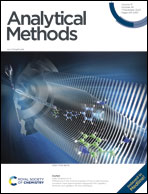N-doped molybdenum oxide quantum dots as fluorescent probes for the quantitative detection of copper ions in environmental samples†
Abstract
A novel, sensitive, and selective fluorescence sensor based on N-doped Mo oxide quantum dots (N-MoOx QDs) was fabricated for the detection of Cu2+ ions in water. The presence of Cu2+ induced dynamic fluorescence quenching of the N-MoOx QDs. The sensing conditions were optimized to enhance selectivity and sensitivity. Under optimal conditions, the linear relationship between fluorescence response at 408 nm and Cu2+ concentration was determined. The linear range of this relationship was 1–100 μM. The limits of detection (LOD) and quantitation (LOQ) for Cu2+ were 0.78 μM and 2.34 μM, respectively. The method was successfully applied to detect Cu2+ in water samples with satisfactory sample recovery rates from 91.7 to 116.4%. The sensor exhibits high selectivity toward Cu2+, making it useful for environmental sample monitoring.



 Please wait while we load your content...
Please wait while we load your content...